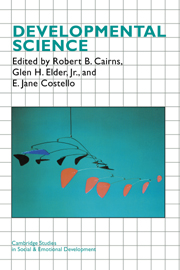Book contents
- Frontmatter
- Contents
- List of Contributors
- Foreword
- Acknowledgments
- Developmental Science:A Collaborative Statement
- 2 Developmental Science: Toward a Unified Framework
- 3 Human Lives in Changing Societies: Life Course and Developmental Insights
- 4 Developmental Psychobiological Theory
- 5 The Question of Continuity and Change in Development
- 6 Primates and Persons: A Comparative Developmental Understanding of Social Organization
- 7 Cognitive Development
- 8 Early Social-Communicative Development: Illustrative Developmental Analyses
- 9 Developmental Psychopathology
- 10 Culture and Cognition in Developmental Perspective
- 11 The Making of Developmental Science
- References
- Author Index
- Subject Index
4 - Developmental Psychobiological Theory
Published online by Cambridge University Press: 09 November 2009
- Frontmatter
- Contents
- List of Contributors
- Foreword
- Acknowledgments
- Developmental Science:A Collaborative Statement
- 2 Developmental Science: Toward a Unified Framework
- 3 Human Lives in Changing Societies: Life Course and Developmental Insights
- 4 Developmental Psychobiological Theory
- 5 The Question of Continuity and Change in Development
- 6 Primates and Persons: A Comparative Developmental Understanding of Social Organization
- 7 Cognitive Development
- 8 Early Social-Communicative Development: Illustrative Developmental Analyses
- 9 Developmental Psychopathology
- 10 Culture and Cognition in Developmental Perspective
- 11 The Making of Developmental Science
- References
- Author Index
- Subject Index
Summary
In recent years, what might be called a “systems view” of individual development has been slowly catching on in both biology and psychology. The developmental psychobiological systems view sees individual development as hierarchically organized into multiple levels (e.g, genes, cytoplasm, cell, organ, organ system, organism, behavior, environment) that can influence each other. The traffic is bidirectional, exclusively neither bottom-up nor top-down. (A formal treatment of hierarchy theory can be found in Salthe, 1985, esp. Chap. 4.) Frances Degen Horowitz's (1987) review makes the systems case for developmental psychology, at least up to a point. (She still accepts some aspects of infant behavior as strictly genetically canalized, or “hard wired”, and makes no mention of the possible prenatal experiential influences on infant behavior.) The geneticist Sewall Wright (1968) and the embryologists Ludwig von Bertalanffy (1933/1962) and Paul Weiss (1959) have long been championing such a systems view for developmental genetics and developmental biology. The systems view includes developmental approaches and theories that have been called ecological (Bronfenbrenner, 1979), transactional (Dewey & Bentley, 1949; Sameroff, 1983), contextual (Lerner & Kaufman, 1985), interactive (Cairns, 1979; Johnston, 1987; Magnusson, 1988), probabilistic epigenetic (Gottlieb, 1970), and individual-socioecological (Valsiner, 1987). For the present purposes, the metatheoretical developmental psychobiological systems view can be fairly represented by the schematic presented in Figure 1.
Information
- Type
- Chapter
- Information
- Developmental Science , pp. 63 - 77Publisher: Cambridge University PressPrint publication year: 1996
Accessibility standard: Unknown
Why this information is here
This section outlines the accessibility features of this content - including support for screen readers, full keyboard navigation and high-contrast display options. This may not be relevant for you.Accessibility Information
- 25
- Cited by
